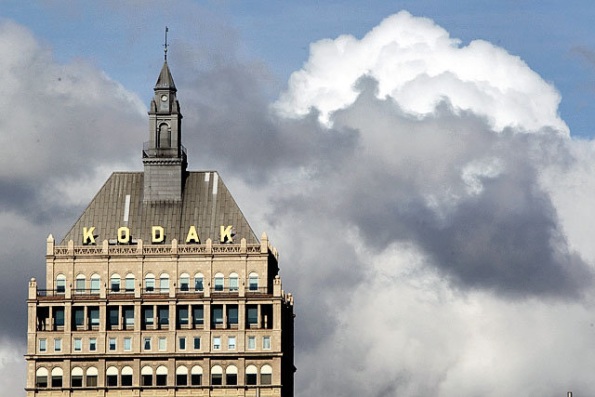End of an Icon: Kodak Prepares to File For Bankruptcy
Its products defined nearly a century of photography, cinema, and home video, but the venerable Kodak company is on the verge of bankruptcy. While the company is reportedly preparing to file a Chapter 11 bankruptcy, which permits restructuring, the firm is caught in a merciless slide.
Once so synonymous with film that its products coined the phrase "Kodak moment," the Rochester, NY-based corporation lost 95 percent of its value between 1999 - 2000. Revenue for 2010 was just $7.18 billion, down from 1996's $15.97 billion. It's stock, which traded at $30-35 per share back in 2006-2007 has fallen to 44 cents as of this writing; the company has been warned that it faces de-listing from the NASDAQ if share prices don't recover to at least $1.
The company's long, slow fall into irrelevancy was caused by its executives consistently failing to recognize the disruptive nature of new companies and technologies. The flaw first showed when Kodak turned down sponsoring the 1984 Olympics. Fujifilm, a cheaper Japanese company, jumped at the privilege, and picked up a 17% share in the US photography market by the late 1990s as a result.

The iconic Kodak building in Rochester, NY
Kodak failed to take digital photography seriously when the technology emerged, believing that Americans would never opt for digital cameras over traditional devices. For a few years, this remained true; early digital cameras were bulky, slow, and took remarkably terrible photos. When it became clear that digital cameras were going to be a major force in the market, Kodak jumped in--but failed to recognize how quickly the devices would become commoditized. In 2001, Kodak was losing $60 per camera sold, even as its film business shrank.
Kodak has attempted to compete more effectively in recent years with a hare-brained attempt to leap into the printer and digital picture frame businesses, both of which feature razor-thin margins and products of dubious quality. Neither move has been very successful. After divesting its manufacturing assets and firing over 20,000 people in the past seven years, the company hit on a last-ditch strategy for success: patent litigation.
The move paid off in 2010, when LG agreed to an $838M payment for patent licensing, and went nowhere thereafter. Kodak has been shopping its patent portfolio around since the summer of 2011, but has yet to find a buyer. Kodak is reportedly eying bankruptcy as a means to purge itself of obligations to fund retiree pensions, the cost of which makes it unattractive to possible buyers.
The larger problem Kodak faces is that the majority of the company's value is tied up in iconic brand recognition and its patent portfolio. Persistent failure to recognize and adapt to changing market conditions has led to a situation where the US corporation with more historic expertise in visual image technology than any other now has nothing to contribute to a medium it was instrumental in creating. As the Wall Street Journal writes: "This company failed long ago."
Once so synonymous with film that its products coined the phrase "Kodak moment," the Rochester, NY-based corporation lost 95 percent of its value between 1999 - 2000. Revenue for 2010 was just $7.18 billion, down from 1996's $15.97 billion. It's stock, which traded at $30-35 per share back in 2006-2007 has fallen to 44 cents as of this writing; the company has been warned that it faces de-listing from the NASDAQ if share prices don't recover to at least $1.
The company's long, slow fall into irrelevancy was caused by its executives consistently failing to recognize the disruptive nature of new companies and technologies. The flaw first showed when Kodak turned down sponsoring the 1984 Olympics. Fujifilm, a cheaper Japanese company, jumped at the privilege, and picked up a 17% share in the US photography market by the late 1990s as a result.

The iconic Kodak building in Rochester, NY
Kodak failed to take digital photography seriously when the technology emerged, believing that Americans would never opt for digital cameras over traditional devices. For a few years, this remained true; early digital cameras were bulky, slow, and took remarkably terrible photos. When it became clear that digital cameras were going to be a major force in the market, Kodak jumped in--but failed to recognize how quickly the devices would become commoditized. In 2001, Kodak was losing $60 per camera sold, even as its film business shrank.
Kodak has attempted to compete more effectively in recent years with a hare-brained attempt to leap into the printer and digital picture frame businesses, both of which feature razor-thin margins and products of dubious quality. Neither move has been very successful. After divesting its manufacturing assets and firing over 20,000 people in the past seven years, the company hit on a last-ditch strategy for success: patent litigation.
The move paid off in 2010, when LG agreed to an $838M payment for patent licensing, and went nowhere thereafter. Kodak has been shopping its patent portfolio around since the summer of 2011, but has yet to find a buyer. Kodak is reportedly eying bankruptcy as a means to purge itself of obligations to fund retiree pensions, the cost of which makes it unattractive to possible buyers.
The larger problem Kodak faces is that the majority of the company's value is tied up in iconic brand recognition and its patent portfolio. Persistent failure to recognize and adapt to changing market conditions has led to a situation where the US corporation with more historic expertise in visual image technology than any other now has nothing to contribute to a medium it was instrumental in creating. As the Wall Street Journal writes: "This company failed long ago."

